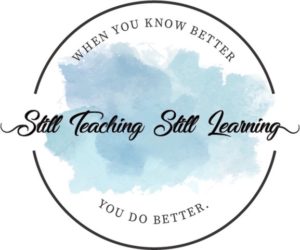
One of the best parts about upper elementary grades is that the curriculum becomes more engaging. Students are more curious about the world. They are also starting to understand that people have different experiences, backgrounds, and viewpoints. Most students ages 8 – 11 enjoy working with partners or small groups and find it to be more engaging.
The job of teaching students who are at different achievement levels continues to be a challenge. Keeping students motivated and engaged can be challenging as well.
(By the way, if you’re new to upper elementary grades or just want to know what to expect, here are eight generalizations I have found helpful. This is the sixth post in a series where I will discuss these eight topics in more depth, along with some tips for addressing upper elementary students’ needs. You can read the first post in the series HERE, the second post HERE, the third post HERE, the fourth post HERE, and the fifth post HERE.)



1 – They want to know the rules and expectations & they expect the teacher to be “the boss.”
2 – They thrive on routine with occasional changes to liven things up – they want you to be predictable, but engaging & fun.
3 – They want to be part of a supportive community. They don’t want to be embarrassed in front of their peers or to feel “stupid”. They worry about bullies.
4 – They want to be more independent & to be asked for their input. They still want to please their teachers (even though some may not show it).
5 – They still love to help and to feel useful.
6 – They want to know their teacher likes them & respects them.
7 – They want to learn more about the world and topics they care about. They question things and want to know the “why.” They are starting to understand different viewpoints besides their own, making for some thoughtful classroom discussions. They still get excited about learning! They will be at very different achievement levels (similar to lower grades), but they are better at hiding their lack of understanding. The curriculum is more difficult, but they can rise to the challenge. Most of them love to work together and find it to be more engaging.
8 – They still want their grownups/families to be proud of them.



In this post, we’ll focus on observation seven. I will give you lots of suggestions for addressing curriculum challenges and engaging your learners.
Upper elementary curriculum can be pretty difficult. Math concepts move from the concrete to the abstract. Reading texts become more rigorous. But with careful scaffolding and modeling, your students will rise to the challenge!
Before we get into some specific content area suggestions, here are some ways to keep the learning engaging for upper elementary students.



KEEPING THE LEARNING ENGAGING
Students at this age tend to be cooperative and love to socialize which makes working in groups an especially engaging way for them to learn. However, this is also the time when competition becomes a bigger issue as well.
Set your expectations and rules for group work. Keep the focus on learning, not on “winning” or “losing.” Encourage working as teams to master content and build confidence in taking learning risks.



Because students are at different achievement levels, you will find some students finishing almost any activity much more quickly than you expected while others seem to take forever.
To address these differences:
1 – encourage/require students to go back and check their work carefully before turning anything in. Stress that finishing early is not the goal.
2 – provide an “anchor activities” list of things that students can always do when they are “done.” No one should ever just be sitting around doing nothing in your class!
Some suggestions:
*independent reading
*finishing incomplete work from another content area
*exploring learning websites like Wonderopolis, Time for Kids, DOGO News, Smithsonian Tween Tribune
*studying math facts (with flash cards or online games)
*word puzzles
*math problem-solving such as Math Superstars
*studying notes from content areas
*studying vocabulary words
Consider making a chart of these activities so you always have a reference available for students.



*Because of the amount of content and the pace of instruction, sometimes you (and your students) are going to need a little downtime to catch up. That’s okay! Try to build it in to your pacing and plan for time to catch up or review. You need the mental break too!
*Take the learning outside (or at least outside of your classroom) whenever you can. This provides a much-needed brain break and keeps the learning engaging.



*See more of my posts about keeping students engaged in their learning below. (Even though some of these posts reference the end of the year, the strategies are effective at any time during the year!)
How to Keep Your Students Motivated & Engaged at the End of the Year
Four Classroom Engagement Strategies for Group Work
Five Classroom Engagement Strategies for Content Area Reading
How to Engage Students’ Brains When Everyone is Ready for a Break
How to Engage Students’ Brains When Everyone is Ready for a Break – part 2
End of Year Activities to Keep your Students Busy & Engaged



UPPER ELEMENTARY CURRICULUM TIPS
It’s important to map out your curriculum for the year. If your district provides pacing guides for curriculum, take a look at those and draw up a map of your year. This way, you can look for resources that will scaffold or enrich your teaching of that content when you get to it.



ELA
Regardless of your curriculum, here are some skills and routines to incorporate wherever possible.
*Read aloud as much as possible! Upper elementary students love to hear picture books and chapter books read aloud. I have found this to be a calming reset at any time of the day.
*Incorporate writing into every subject. This builds necessary writing practice and helps them see the value of writing for clarifying their thinking.
*A great anchor activity is to let your students write for fun. We Are Teachers website has some fun writing prompts.
Third grade writing prompts
fourth grade writing prompts
Fifth grade writing prompts
You don’t have to read/grade everything they write! They can share their writing in class discussions, share with partners or small groups, or not share at all if they don’t want to. The practice of writing is the point.



*Most students still need explicit writing instruction. Hopefully, your district provides writing curriculum resources, but if not, here are some favorites:
~The Writing Revolution by Judith C. Hochman & Natalie Wexler
~Writing Our World (daily lessons based on The Writing Revolution)
~The Syntax Project (based on The Writing Revolution)
~Empowering Writers books
~Any books by Barbara Mariconda
*Continue to write narrative stories, but also expand writing genres to include writing informational texts, persuasive or opinion texts, summaries, letters, and poetry.
*As you teach your students to write informational texts, you can also teach important research skills of paraphrasing information and citing sources.



*Help develop an appreciation for poetry by sharing favorite poems and books of poetry with your students.
One fun thing to do as an anchor activity is to allow students to create their own poetry anthology. This consists of blank paper inside a construction paper cover. Students use the blank paper to copy a favorite poem, along with the poet’s name and the poem’s source. (This serves as good handwriting practice as well.) Then you can allow students to decorate the page (as long as they don’t spend all day doing that).
*Teach and expect appropriate use of punctuation.
*Teach students to speak & write in complete sentences.
*Teach cursive writing and practice it frequently. (This could be done in those poetry anthologies I mentioned. Another fun thing to do is to practice copying a quote every day.)



*If you’re familiar with Science of Reading research, you know that building knowledge is critical to helping all students develop reading comprehension. (You can read more about that in The Knowledge Gap by Natalie Wexler.) Here’s a link to my posts about how to build knowledge in your upper elementary classroom.
How to Address the Knowledge Gap in Your Classroom
How to Build Valuable Background Knowledge to Boost Your Students’ Reading Comprehension
*Building vocabulary is also super important. I love Jen Bengel’s resources. Here’s a link to her sets for grades 3 – 6 (one for each grade).
We Are Teachers has some more fun vocabulary activities in this post.
Another option is to keep a chart on the wall and add vocabulary words when you teach their meaning to your students. The good thing about a chart like this is that it reminds you to review the words frequently. You can do this in small chunks of time.



*Use orthographic mapping to teach multisyllabic words. This builds decoding skills, spelling skills, and vocabulary skills. (A great resource for all kinds of phonics activities is David Kilpatrick’s Equipped for Reading Success.) This blog post explains the how and why of orthographic mapping.
*Teach morphology! A great resource for this is the Morphology Project. Here is a resource for teaching Greek and Latin roots.
*Teach figurative language and point it out in every text where possible. Idioms are especially fun for upper elementary students. This website explains the meaning of some popular idioms. (Idioms are also fun to illustrate.)



*If you’re interested in a structured literacy program for upper elementary students, I recommend Bri Luna’s Reading Rev program. She has lots of free resources on her website that give you an idea of what her resources are like.
*Occasionally incorporate book groups to discuss books together during your literacy block. (If students are not able to read the book independently, look for a recording of the book online or in your library. Another option is to allow students to read the book together.)
*My favorite go-to resources for upper elementary ELA are The Stellar Teacher Company and Jennifer Findley’s website.



MATH
*Provide lots of practice with math fact fluency. This post from Count on Tricia and this post from Math Coach’s Corner will give you some great ideas for how to do that.
Mathigon is a great website for all kinds of math resources. Their Multiplication by Heart practice is especially good.
*Here are my strategies for implementing (or re-implementing) your math block.



*Incorporate math centers. Donna at Math Coach’s Corner explains how to set that up HERE.
*Include math games in your math centers. Students enjoy practicing when the practice is in game form. Here are some links to some games on the We Are Teachers website.
North Carolina’s Department of Public Instruction has also created some great math games that require little prep or resources. Here are the links.



*Teach math word problem strategies. This post gives some suggestions.
*Provide lots of practice with fraction concepts.
*I have been exploring the Inside Mathematics website. If you click on “Inside Problem Solving,” you will find lots of great tasks for students to solve. The “Math Cuts” section includes quick videos for professional learning.
*Here is another good resource for math tasks!



*My go-to math resource sites for upper elementary are Math Coach’s Corner, Math Geek Mama, and Teaching with Jennifer Findley.
*I have another post about upper elementary math resources HERE. If you need suggestions for establishing (or re-establishing) math norms in your classroom, here are some tips.



CONTENT AREAS
*Use as many hands-on science opportunities as possible! Once again, We Are Teachers website has lots of great ideas. You’ll need to scroll through these posts to find options that fit your particular science curriculum.
*Take as many field trips as possible! Yes, I know that planning and paperwork are a pain, but the learning opportunities (usually) make it all worthwhile.
In the United States, some general options that fit the curriculum include the following:
*zoos and aquariums
*state or national parks
*local historic sites
*state historic sites
*science museums
*history museums
*anything related to the Revolutionary or Civil War eras
If time and finances are an issue, try taking some virtual field trips! Here is my list.



*Make connections to real-world events (keeping in mind the need to make it age-appropriate). Some options:
~CNN 10
They also include a transcript of the short (10-minute) videos and sometimes there is a news quiz as well.
~NewsELA (some articles are behind a paywall)
Good news magazines with subscriptions:



*Allow students to use maps frequently. Locate cities and towns within your state, locate states in the U. S., and locate countries around the world. This helps teach geography skills.
*Provide opportunities to learn about people who have had a positive impact in the world (both living and no longer living). BrainPop often has videos for different month-long celebrations such as Black History Month and Women’s History Month.
*Use the website Wonderopolis any time you have a few free minutes! You can use the “Wonder of the Day” or search for something related to your current curriculum area of study.



*Finally – here is my list of some great content area resources.
I hope you found some helpful suggestions for planning age-appropriate and engaging activities for your upper elementary students.
Please subscribe for more upper elementary tips, plus resources for managing your teacher time and taking care of yourself!
For my upper elementary veteran teachers, what would you add to this list?
All of my content is intended to save teachers time and energy. Making good teaching sustainable – while also having a life outside of teaching – is my goal. Let me know how I can help YOU with this quick form!
